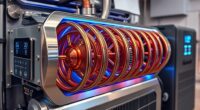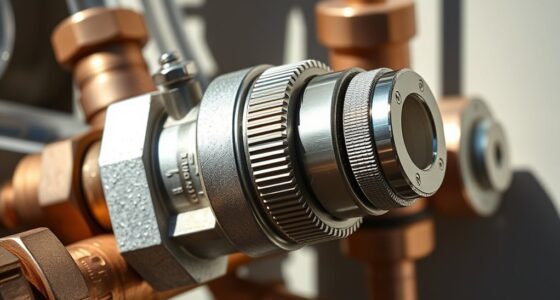The history of the heat pump refrigeration cycle begins with early experiments by William Cullen and Jacob Perkins, who demonstrated basic cooling using ether. Later, pioneers like Lord Kelvin and Peter von Rittinger refined the theory and created prototypes that used vapor compression and latent heat. Over time, innovations in refrigerants, compressor technology, and control systems made these devices more efficient and widespread. Exploring further reveals how modern advancements continue to shape sustainable heating and cooling solutions worldwide.
Key Takeaways
- Early experiments by William Cullen and Jacob Perkins in the 18th and 19th centuries demonstrated artificial cooling and foundational refrigeration principles.
- Lord Kelvin and Peter von Rittinger developed theoretical models and the first practical vapor compression heat pump in the mid-1800s.
- Rittinger’s 1856 demonstration showcased latent heat transfer using water vapor, transitioning heat pumps from theory to industrial application.
- The 20th century saw innovations in refrigerants, compressor technology, and cycle design, enabling large-scale heating and cooling systems.
- Modern developments include eco-friendly refrigerants, inverter controls, and AI-driven systems, expanding efficiency and sustainability of heat pump cycles.
Early Foundations of Thermodynamics and Refrigeration

The development of heat pump refrigeration cycles has its roots in the early discoveries of thermodynamics and refrigeration. In 1748, William Cullen demonstrated artificial refrigeration by using an ether-based cooling system, laying the groundwork for thermodynamics principles. Jacob Perkins built the first practical refrigerator in 1834, employing diethyl ether to enable refrigeration through heat transfer. In 1852, Lord Kelvin described the theoretical basis of heat pumps, highlighting how reversing refrigeration cycles could provide heating. Meanwhile, Peter von Rittinger developed and operated the first heat pump between 1855 and 1857, utilizing water vapor’s latent heat for efficient heat transfer. These pioneering efforts and foundational insights established the essential concepts that would evolve into modern heat pump refrigeration cycles.
Pioneering Theoretical Insights and Prototype Development

You can see how Carnot’s work in 1824 laid the groundwork for heat pump concepts by establishing the principles of heat transfer and efficiency. Kelvin’s expansion in 1852 clarified how mechanical work could move heat between sources, even without a practical device. Then, in 1856, Rittinger built the first operational heat pump, proving that moving heat efficiently was achievable in real-world applications.
Early Thermodynamic Foundations
Have you ever wondered how the principles behind modern heat pumps took shape? Early thermodynamic insights began with Carnot’s 1824 work, which established the theoretical foundation for heat engines and the Carnot cycle. This cycle explained how heat transfer and thermal efficiency could be maximized, inspiring subsequent refrigeration concepts. William Thomson, or Lord Kelvin, in 1852, expanded on these ideas by describing the reverse cycle essential for heat pump operation. Pioneers like Peter von Rittinger built the first practical heat pump prototype in 1856, demonstrating heat transfer using vapor compression and latent heat. These early experiments confirmed that reversing the Carnot cycle could transfer heat efficiently, laying the groundwork for future refrigeration systems and the development of the vapor compression cycle that underpins modern heat pumps. Additionally, advancements in thermodynamic cycles and materials have continued to improve heat pump efficiency and performance over time, supported by ongoing research into energy-efficient designs. Moreover, the integration of refrigerant technology has played a crucial role in optimizing the performance of these systems. Understanding the history of thermodynamics provides valuable context for ongoing innovations in heat pump technology.
First Prototype Demonstrations
How did early scientists turn thermodynamic principles into functional machines? They built prototypes based on foundational ideas. In 1856, Peter von Rittinger demonstrated the first operational heat pump, showcasing practical demonstrations of the refrigeration cycle. His early design used water vapor’s latent heat to transfer heat efficiently, marking a pivotal breakthrough. This prototype proved that heat pumps could be applied to industrial processes like drying wood and evaporating brine. These demonstrations transitioned heat pump technology from theory to real-world applications, highlighting the importance of latent heat and vapor behavior. Rittinger’s pioneering efforts laid the groundwork for future innovations, making the heat pump a crucial component in industrial applications and advancing the development of modern refrigeration cycles. The understanding of the refrigeration cycle was essential for refining these early prototypes and improving their efficiency. Lesser-known spots provide tranquility and privacy for enthusiasts seeking a peaceful experience.
Industrial Advancements and the Emergence of Practical Systems
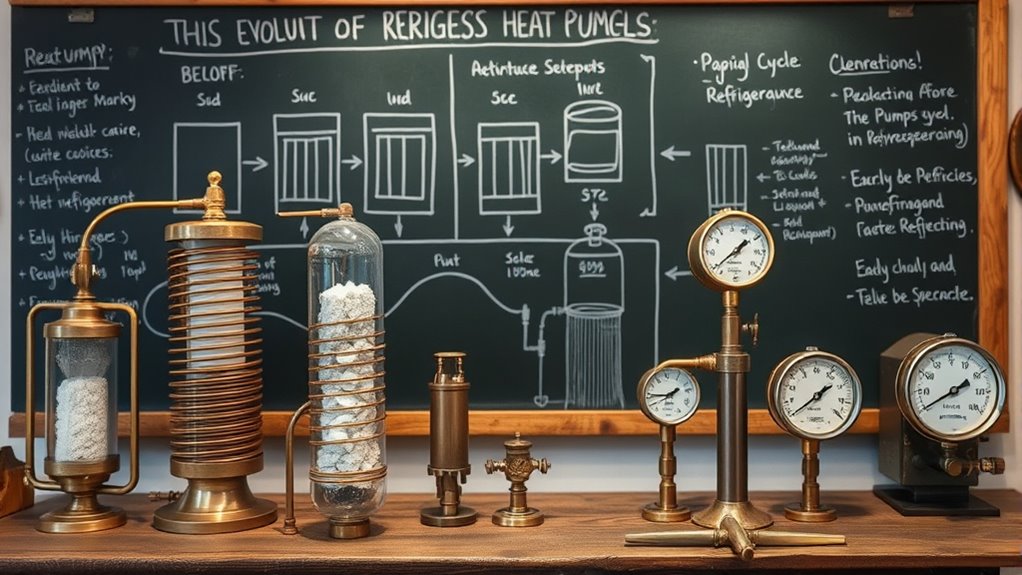
The shift from theoretical concepts to practical industrial systems marked a significant milestone in heat pump technology. Peter von Rittinger’s water vapor-based heat pump in the 1850s demonstrated how refrigeration technology could be applied industrially for drying and evaporating processes. As refrigerants like ammonia and water-lithium bromide emerged in the early 20th century, heat pump systems became more efficient and reliable. Advancements in compressor design, materials, and control systems enabled larger-scale thermal transfer, making industrial heat pumps more practical and effective. These innovations drove market adoption, allowing industries to leverage heat pumps for heating and cooling applications. Moreover, industrial refrigerants played a crucial role in enhancing system performance and safety, further propelling adoption. Additionally, the development of control technologies improved the precision and responsiveness of industrial heat pump systems, increasing their versatility. The integration of smart control systems has further optimized operational efficiency and adaptability in various industrial settings. Overall, these industrial advancements transformed heat pump systems from experimental devices into essential components of modern thermal management. Renewable energy innovations continue to enhance the efficiency and sustainability of heat pump systems today, with advanced refrigerants playing a crucial role in improving environmental impact.
Integration With Refrigeration Technology and Commercial Applications

You can see how refrigeration technology has seamlessly integrated into heat pump systems, enabling versatile commercial applications. The adoption of vapor-compression cycles and components like condensers and evaporators has expanded their use in industries from food preservation to district heating. Advances in refrigerants and compressor controls continue to improve efficiency, making these systems more sustainable and effective. Additionally, the understanding of ice cream quality and ingredients has driven innovations in refrigeration systems to better preserve product integrity and flavor. For example, the development of environmentally friendly refrigerants has contributed to reducing the environmental impact of cooling systems, aligning with the ongoing pursuit of sustainable refrigeration.
Evolution of Refrigeration Cycles
As refrigeration technology advanced, the vapor-compression cycle became the foundation for most air conditioning and heat pump systems because of its high efficiency and flexibility. You can see how this refrigeration cycle, with its adaptable design, enabled seamless switching between cooling and heating modes in heat pump development. Throughout the evolution, improvements in refrigerant evolution and compressor design boosted performance and reliability. Commercial applications expanded from industrial processes like salt production to residential heating and cooling, reflecting the cycle’s versatility. These advances helped maximize energy efficiency and made heat pumps a practical choice for diverse environments. Today, the integration of refrigeration technology continues to evolve, shaping smarter, more efficient heating and cooling solutions. Enhanced refrigerant options improved safety and efficiency. Modular compressor designs increased system durability. Broader applications expanded the cycle’s commercial reach.
Industrial and Residential Uses
Did you know that the integration of refrigeration technology into heat pumps has shaped both industrial and residential heating and cooling solutions? Today, the refrigeration cycle plays a crucial role in various applications. Residential heat pumps, for example, utilize air-source heat as a heat source, offering efficient thermal management for homes. Advances in compressor efficiency and refrigerants have improved performance, especially in colder climates. In industrial applications, systems like hybrid absorption-compression heat pumps leverage refrigeration cycles to optimize energy use. These systems often connect with existing refrigeration infrastructure, enhancing overall efficiency. The development of refrigerants and innovative heat sources has expanded the versatility of heat pumps, making them integral to modern heating, cooling, and thermal management across sectors. Additionally, understanding the refrigeration cycle is essential for optimizing system performance and environmental impact. The evolution of refrigerants has been vital in reducing greenhouse gas emissions associated with these systems. Furthermore, ongoing research into refrigeration technology continues to improve efficiency and sustainability of heat pump systems, highlighting the importance of system design in achieving energy goals.
Modern Innovations and the Rise of Energy-Efficient Systems
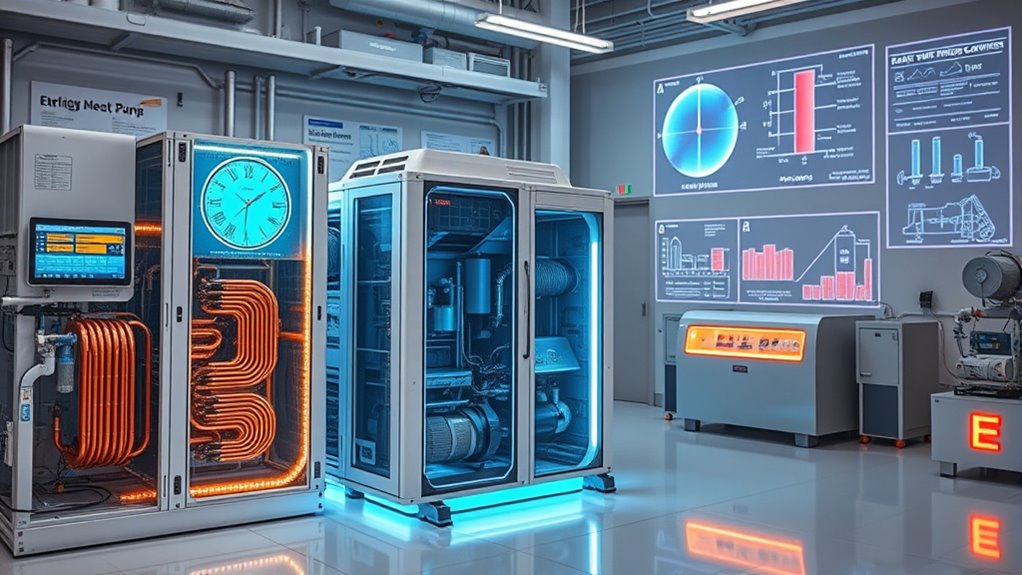
Modern innovations have propelled heat pump technology toward greater energy efficiency and environmental sustainability. You now benefit from inverter technology, which adjusts compressor output for ideal performance in various conditions, especially cold climates. Smart controls and advanced control algorithms enable real-time adjustments, maximizing seasonal coefficient of performance (SCOP) and reducing energy consumption. Eco-friendly refrigerants like R-32 and R-134a enhance sustainability without sacrificing efficiency. High-temperature heat pumps expand heating capacity, making them suitable for renewable energy integration and reducing reliance on fossil fuels. Additionally, hybrid absorption-compression systems offer flexible operation modes, boosting overall efficiency. These advancements collectively transform refrigeration systems into more sustainable, cost-effective solutions, supporting your goal of reducing environmental impact and lowering energy costs. Furthermore, ongoing research into refrigerant development continues to improve the environmental footprint of these systems. As the industry faces increasing AI security concerns, innovative safety measures are being integrated into control systems to ensure reliable operation. Incorporating system optimization techniques further enhances overall performance and energy savings. Moreover, advancements in component durability contribute to longer system lifespans and reduced maintenance needs. Emphasizing Hydrogen Energy in the development of alternative energy sources offers promising opportunities for decarbonization and sustainable cooling solutions.
Future Directions in Heat Pump and Refrigeration Cycle Technologies
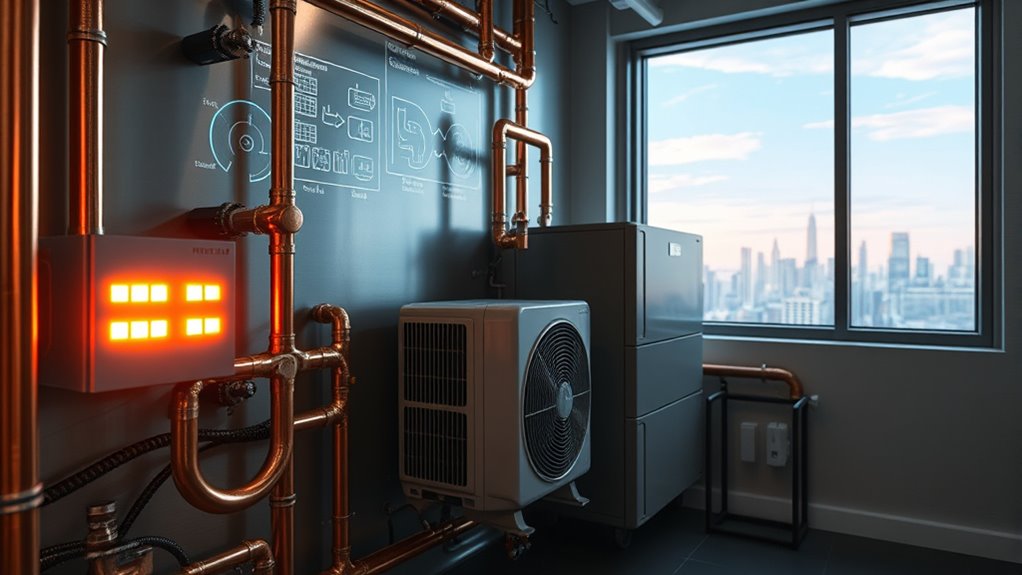
Advancements in inverter technology and eco-friendly refrigerants are opening new possibilities for heat pumps to operate efficiently at lower temperatures and in colder climates, substantially expanding their practical applications. Future innovations in thermodynamic cycles aim to enhance energy efficiency and reduce environmental impacts. High-temperature heat pumps are being developed to replace traditional systems in industrial processes, utilizing renewable energy sources. Hybrid systems, such as absorption-compression heat pumps, combine multiple cycle types for ideal performance. Smart controls and AI-driven adaptive systems improve efficiency, enable predictive maintenance, and facilitate integration with renewable energy grids. Ongoing refrigerant technology research focuses on designing safer, sustainable refrigerants that minimize environmental harm. Additionally, arcade machines and their innovative mechanisms inspire advancements in control systems and user engagement strategies. These advancements collectively point toward a more efficient, eco-friendly future for heat pump and refrigeration cycle technologies. The evolution of thermodynamic principles, including energy-efficient cycles, continues to influence the development of these systems, ensuring ongoing improvements in performance and sustainability.
Frequently Asked Questions
What Is the History of Heat Pump System?
You might wonder about the history of heat pump systems. They date back to the early 19th century, when Sadi Carnot theorized thermodynamic cycles. Over time, pioneers like Rittinger and Carrier built practical models, and residential systems appeared in the 1930s. Today, advancements like inverter technology have made heat pumps more efficient and versatile, shaping modern climate control solutions you rely on.
What Is the Refrigeration Cycle of a Heat Pump?
Imagine your heat pump as a clever artist, constantly swapping roles to keep you comfortable. Its refrigeration cycle is a reversed vapor-compression dance, moving heat from one place to another. You start with refrigerant absorbing heat in the evaporator, then it gets squeezed in the compressor, releasing warmth in the condenser. When reversed for cooling, the cycle switches, keeping your indoor air fresh and cool.
Where Did the Refrigeration Cycle Come From?
You’re curious about where the refrigeration cycle came from. It all started in the 18th century when William Cullen demonstrated artificial cooling, and later, Jacob Perkins built the first practical vapor-compression refrigerator. The theory was developed by Lord Kelvin, and early experiments with water vapor heat pumps by Peter von Rittinger laid the groundwork. Over time, innovations with refrigerants like ammonia and Freon made the cycle more efficient and practical.
What Is the Primary Refrigeration Problem in a Heat Pump System?
When it comes to heat pumps, the main challenge is that you’re always chasing your tail. You need efficient heat transfer between indoors and outdoors, but low outdoor temps make it hard for the refrigerant to absorb enough heat. Frost buildup on coils, pressure drops, and rejecting heat in high outdoor temperatures can all cause issues. Overcoming these problems is key to keeping your system running smoothly and efficiently.
Conclusion
You’ve seen how early ideas sparked innovation, turning theory into practical solutions. From pioneering prototypes to modern, energy-efficient systems, each step built upon the last. Today, as technology advances, you’re at the forefront of sustainable heating and cooling. The journey from basic thermodynamics to smart, integrated systems reflects progress and potential. Embrace these innovations, where history and future meet, shaping a world that’s warmer, cooler, and more efficient.

